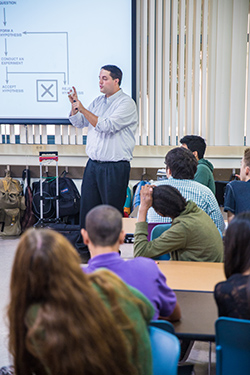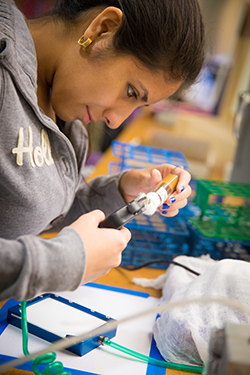
By:
- Catherine Hockmuth
Published Date
By:
- Catherine Hockmuth
Share This:
Putting Their Heart Into It
Bioengineers team with high school students to study age-related heart disease as part of STEM outreach program

UC San Diego bioengineering professor Adam Engler talks to 11th grade biology students at High Tech High School in Point Loma.
Bioengineering professor Adam Engler needed to answer a question: Do genetic mutations in the heart, mutations that are common in humans as we age and that are correlated with poor heart function, also contribute to a shortened lifespan?
To help find the answer, Engler turned to a group of biology students at High Tech High School in San Diego. The students, all members of Jesse Wade Robinson’s 11th grade biology course, have been learning about the meticulous scientific process required to accurately collect and analyze data. Engler wants them to use those skills to help him study fruit flies suffering from similar genetic heart mutations to those found in humans.
It’s Day One of the experiment and the students pepper Engler with questions: Why just genotype? Isn’t life span affected by many more variables such as diet and exercise? Let’s say the experiment shows that the gene mutation does affect the lifespan of the fly, what’s your next step?
These are the kinds of thoughtful, probing questions that professors love to hear, especially from high school students they are hoping will get excited enough by the scientific process to become scientist themselves. Many, like Engler, incorporate this kind of K-12 outreach into their laboratory research by design. It gives students considering educational and career goals some insight into what it’s like to work in science, technology, engineering and mathematics (STEM) fields. Giving students an opportunity to gain this experience on a project that has real impact in the world of medicine is what High Tech High, which emphasizes project-based learning, is all about.
“This is really important research we’re conducting to figure out why some people have a higher chance of having heart disease,” Engler tells the students before launching into a demonstration of the research team’s hypothesis and the important role the students will play in determining whether the flies’ genotype also affects their lifespan. “We’ve conducted a lot of different experiments to prove that it does affect heart function, but what we haven’t done is determine if that negative heart function has any outcome in the lifespan of the fruit flies. That’s where you all come in. In six weeks, we’re going to have the first hard data either way thanks to your work.”
The students learn that fruit flies serve as excellent models for studying heart disease in people. Despite obvious differences between fruit flies and humans, both species have remarkably similar heart genetics. In fact, the proteins in the heart of the fruit fly are 82 percent similar to humans. Fruit flies’ relatively short six-week lifespans also allow researchers to study disease cycles in an accelerated mode.
The students have been charged with caring for, feeding and monitoring the flies over the next six weeks, painstakingly recording any deaths and whether they stemmed from “natural” or “unnatural” causes. Everything must be recorded to maintain the integrity of the data.
Gaurav Kaushik, a Ph.D. candidate working in Engler’s lab, explains that the flies have been separated into groups determined by the presence (or not) of selected genetic mutations. They have been separated by gender to prevent reproduction. The flies are all eating the same food and living in the same conditions to remove any other variables that could contribute to a shortened lifespan. The students don’t know whether their flies are mutants or normal to prevent them from introducing bias into the study, Kaushik explains.

Mariel Higareda, a biology student at High Tech High School, practices anesthetizing fruit flies with CO2 in preparation for a study on genetic heart mutations that may affect lifespan.
Once the flies have all died, the students will work with math teacher Amy Callahan to plot their deaths on a chart and present their findings about the longevity of the flies in their care. Engler and Kaushik are looking for big, premature drop-offs in the numbers. If large numbers of mutants die in the first weeks – well before the typical lifespan of a fruit fly – that will be clear evidence that the genetic mutations are a significant factor in longevity.
"The problems of the 21st century, such as heart disease, cannot be solved unless we take an interdisciplinary approach. This is why I am thrilled that the students will be working on this project in both their biology and mathematics classes,” said Robinson. “The students will need to think mathematically and scientifically to complete the project."
The students are abuzz with a sense of purpose and responsibility for their project, a major goal of the High Tech High approach to education. They ask more questions about Engler’s research and what the study will show. And they totally immerse themselves in the meticulous demands of careful scientific observation.
“Having a project that has to do with something that’s going on in the world is really helpful to actually getting engaged in the project,” said Lizzy Marples, an 11th grader who wants to study neuroscience in college. “We know that we’re doing something that’s helpful.”
Share This:
You May Also Like
Stay in the Know
Keep up with all the latest from UC San Diego. Subscribe to the newsletter today.


